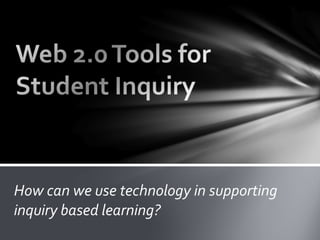
Using Web 2.0 Tools for Student Inquiry
- 1. How can we use technology in supporting inquiry based learning?
- 3. Inquiry requires more than simply answering questions or getting a right answer. It espouses investigation, exploration, search, quest, research, pursuit and study. It is enhanced by involvement with a community of learners, each learning from the other in social interaction. ” Kuklthau, Maniotes & Caspari, 2007, p. 2 ”
- 5. Models of Inquiry. http://www.flickr.com/photos/nechbi/53014709/
- 6. Learning for All – Ontario Library Association
- 10. Ontario – Student Inquiry Process Ontario Ministry of Education
- 11. Model OLA BCTLA SS MoE Stage 1 Exploring Connect & Wonder Initiate & Plan Focus Stage 2 Investigating Investigate Perform & Record Explore Stage 3 Processing Construct Analyze & Interpret Analyze Stage 4 Creating Express Communicate Share Learning Stage 5 Reflect Reflection & Feedback throughout
- 20. Ideas from you!
- 21. 4. Share Learning/Communicate/Discuss/Demonstrate http://www.flickr.com/photos/soomaa/6626864445/
Editor's Notes
- Outline the session – want to look briefly at 4 different models of inquiry learning and how they compare and differ. Then we ’ll look deeper into the sections of one of them and discuss how schools can be support for those things, then if we have time, I can quickly outline an example from the science curriculum. I want this to be a discussion about what you do, and how you can help in all areas, with examples of what you do.
- Just some of the Web 2.0 tools that exist. Add to this the plethora of ‘traditional’ web tools and you have an overwhelming list of choices!
- This is from the Ministry monograph on Student Inquiry. You ’ll each get a copy of that.
- In my opinion, its about the questions. Student inquiry should be driven by questions. Their questions, the things that they wonder about, the things that excite them. Our job as teachers is to aim them in the right direction, starting from the curriculum, but primarily guided by the students. This can get messy, and go in a hundred different directions, and that’s ok.
- There is more than one way to get to an end. If we use the curriculum as a starting point, and focus on things skills and not a checklist of specific expectations, then the direction that the students take doesn’t matter when they all learn together.
- This is the model from OLA – Together for Learning. It ’s a fairly detailed one in that it gives some options at each section that can help to frame and focus the learning goals.
- BC Teacher Librarian Association – another basic model that guides the process.
- Smarter Science is a science focused inquiry process. It ’s built around the idea of getting students able to develop testable hypotheses with science experiments or other science activities. It can be used in a variety of ways, as it’s got a variety of skill based components that you can drill into each one. This is built on the foundation skills from the curriculum.
- This is the whole SS framework, with all the 50 + skills that can be looked at in each of the 4 areas.
- This is from the Ontario – LNS Monograph. It ’s a montage of a few models that can be applied to many different areas. A key difference or addition is the reflection and feedback in the middle is meant to be continually applied and looked at. This happens at all areas and throughout the learning process.
- Here ’s a comparison of the 4 models that we looked at. Look at similarities and differences. Basically they are all built on similar ideas.
- So lets look at the Ontario model a little more closely and how the teachers and technology can support in each case. Use the Inquiry Monograph to guide discussion and thinking.
- Ask the question, how do we support this? What do we do with teachers and students to help them formulate questions?
- Once you have a question, it’s time to dig in. Here’s where you find information, gather data, experiment.
- This is the area where students are exploring and investigating. Gathering info and data relevant to their question. How do we extend thinking, model the process, provide opportunities for peer/self assessment?
- How do we strategically question to help students extend and clarify thinking? Drawing conclusions? Thinking critically?
- How do we support reflection, and the demonstration of learning? Can we guide and support them as they demonstrate and reflect on their learning. Can we use the classroom time to support the creation of different kinds of artifacts?
